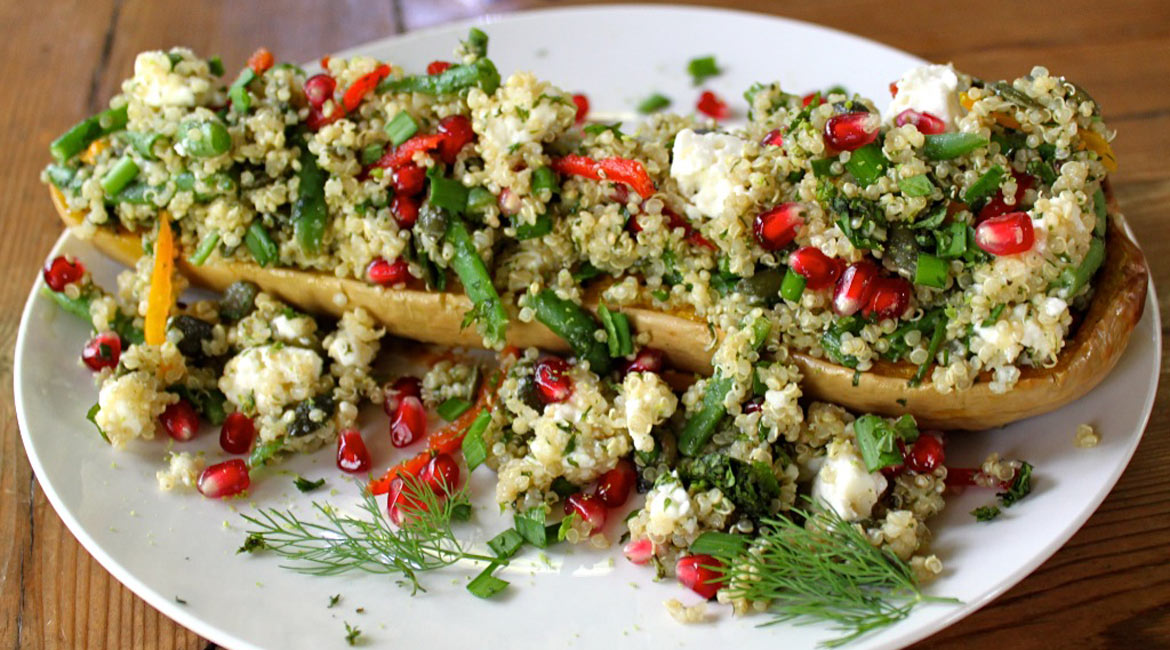To me, the hour-glass butternut is like one of those friends who, when you bump into on occasion, leaves you feeling energized and happy to be alive. And if my recent research is correct, I’m not the only one who’s affected this way. Native Americans, the first people to introduce butternut squash to the New World, buried the gourds with their dead so as to provide nourishment during the journey into the afterlife. The butternut seeds, I learned, were also said to increase fertility, thus were often planted around their encampments.

Butternut squash grows like a weed around here. We plant them arbitrarily and let them wander their way under the fruit trees, through the pole beans, and into the Swiss chard, only being redirected when threatening to strangle or suffocate a neighbor.
I discovered last year that the plants were in far better health during the rain-drenched summer months. In the cooler, dry winter, when we had to irrigate from the Zambezi River regularly, all our squash varieties were afflicted with downy mildew. We tried spraying the leaves with a mixture of milk, water and bicarbonate of soda, a recommendation I found on the internet, but it proved near impossible to get rid of completely. (If any of my readers have an effective organic solution they use for dealing with downy mildew, I’d be most grateful if you shared it with me.)

This humble vegetable is packed with nutrition — chock-a-block with vitamins B6 and C, potassium, folate, beta-carotene, antioxidants, and the all-important dietary fiber — it’s no wonder the likes of Martha Stewart regard it as a “power food.”
Butternut squash is the most versatile vegetable which I cook with throughout the year. It’s terrific in a risotto, ravioli, as a soup or salad, and goes with all roasted and grilled meats. I often substitute butternut for potatoes because it is so much better for you.

In contrast with the low-key butternut, the other power food I use in this recipe is the sumptuous pomegranate. ‘Tis the season again for this exotic to be consumed tree-to-mouth, and when they are not being eaten or juiced, we’re bagging pound after pound of arils to be frozen for use later in the year.
Deseeding pomegranates can be a messy business and the juice, like blood, is a challenge to remove from your clothes. Here, we break open the pomegranate underwater, which not only allows for the careful removal of the seeds without bursting and squirting you, but it easily separates them from the weightless white pith that will then float straight to the surface.

Whenever we’re making a dish that uses loads of different vegetables, we save all the cuttings and peels to throw into the stockpot. Our freezer is never without a supply of stock, be it vegetable or meat-based. In this recipe I used vegetable stock, which adds more flavor to the quinoa than if you cooked it in water. Other alternatives include toasting the quinoa in a little olive oil before boiling, or adding a shot of wine or flavored oil to the water.

The following low-carb, gluten-free recipe makes for a delicious summer lunch.
Roasted Butternut Squash stuffed with Jeweled Quinoa
Yield: 2-4 servings
Ingredients:
- 2 butternut squash, halved
- 1/4 teaspoon freshly ground nutmeg
- 1/4 teaspoon freshly ground black pepper
- Salt to taste
- 2 tablespoons olive oil, divided
- 1 heaped cup quinoa
- 2 cups vegetable stock (or water)
- 1/2 cup pumpkin seeds, dry-roasted
- 2 medium bell peppers (preferably different colors), deseeded, and finely sliced lengthwise
- 1 cup green beans, cut into bite-size lengths and blanched
- 1/2 cup pomegranate seeds, divided
- 1/2 cup garlic chives, finely sliced
- 3/4 cup fresh mint, finely chopped
- 1/4 cup fresh dill, finely chopped
- 1 cup feta cheese, cut into bite-sized pieces
- Zest and juice of 1 lime

Method:
- Preheat the oven to 180/350 degrees. Cut the butternuts in half, remove the seeds, coat with olive oil, and season with grated nutmeg, salt and pepper. Roast in the oven for about 45 minutes, depending on their size.
- While the butternuts are roasting, rinse the quinoa under cold water.
- Bring the vegetable stock to the boil, add the quinoa, stir until well-combined, cover, and reduce the heat to a gentle simmer. Cook for about 15 minutes (it is done when the individual seeds look like they have opened). Fluff up with a fork and break up any lumps. Cool slightly.
- Remove the roasted butternuts from the oven, cool slightly, and groove out the flesh from the neck with a teaspoon. Try not to break the skin.
- Combine the rest of the ingredients, including half of the pomegranate seeds, the small chunks of butternut you carved out of the neck, and the remaining spoon of olive oil. Gently fold in the quinoa, ensuring the ingredients are well-combined. Season to taste.
- Spoon the quinoa mixture into each butternut half, and decorate with sprigs of dill and mint.
- Serve warm.



28 Comments
Brilliant Annabel … stunning photos of the fresh produce from the gardens of LivtoBee!
Looking forward to making this 🙂
Thank you, Dee! This can, of course, be made with all sorts of variations. We just had these lovely color combinations in the garden. xo
Looks amazing!
Thank you, Georgie! (It’s yummy, too …)
I love butternut! So delicious – one of our fairly basic family curry recipes includes butternut, spinach, garlic and chili (as well as the other bits)!!
Butternut is such a keeper … your curry sounds delicious. Why don’t you blog on it? 😉
Beautiful dish, and what a great tip for extracting pomegranate seeds. I always wonder how Persephone kept her gowns clean. 😉
Haha, Michelle! I’m a big Persephone fan, but have never pondered THAT conundrum before. Maybe Hades granted her access to his Underworld’s dry cleaning facility? 😉 Lovely to hear from you, as always!
Well, I’ve ruined many a white tee shirt with them!
So have I … and kick myself often for wearing white in the kitchen. Turmeric does some damage, too!
Butternut a favourite of mine here in NZ. It has been quite hard to find but hoping to see lots now we are into Autumn. Try Otto Lenghi’s roast butternut with tahini drizzzle – sublime
I love Ottolenghi, Lillias … and just bought his latest book, Plenty More, on our recent trip to Australia. Enjoy the NZ butternuts!
Annabel, you never cease to inspire! Thanks for the innovative ideas on butternut squash preparation. I’m a huge fan of this humble squash and need to venture past the cinnamon and butter!! I do love chopping up cubes of it in my Sunday soup, where I root thru the fridge to make a kettle of soup and put anything not too past its prime into my trusty copper pot, chicken, leeks, carrots, parsnips, garlic, potatoes, quinoa, wild rice, vege stock, whatever….the butternut squash adds color, texture, & a wonderful layer of flavor, my friends want my recipe but there isn’t one, I know you get it! Miss you!
Thank you for your sweet comment, Sandi. Your soup sounds wonderful, especially for all those northern hemisphere readers gagging for some warm Spring days! Butternut is the ultimate comfort food … and so, so good for you, too! Thanks for stopping by. I miss you back! xo
What a beautiful dish to put on the table. Imagine it at Christmas with those traditional Christmas colours.? A must for vegetarians! I don’t grow butternuts sadly but always find it fun to look in the shop for butternuts that don’t have too big a tummy with an empty space and lots of seeds. A bonus is finding one with a long neck !!
Annabel, when I spray for mildew I don’t include the milk.. Years ago I was working on getting garden pots sorts of fungus looking I washed them in buttermilk.. encouraged the green mould. I spray the roses with bic-carb and water, no milk… I don’t know it might help?
Thank you so much for your lovely comment, Hellie … and THANK YOU for passing on your advice regarding mildew. I was really hoping someone else had tried removing it organically, and I should have guessed that would have been you! I am definitely going to give your way a go this coming winter. Huge gratitude … xo
That is beautiful. Just beautiful!
Thank you for your lovely comment, chef mimi. It’s a recommended combo, for sure!
This looks like an exotic meal. Fresh and vibrant colors..
Thank you for your kind comment, skd. It looks exotic but is actually very simple to put together, as long as you have access to the ingredients. Thank you for stopping by my blog. All the best to you … Annabel
It was a pleasure surfing through your blog. Have a nice day Annabel.
This is really an innovative and a healthy dish
Thank you so much … and thank you for stopping by my blog! All the best to you … Annabel
Have to reveal my ignorance here – which feels safer with a friend like you, Annabel.. WTH: Is quinoa another name for unprocessed cous-cous? Whatever, where do I get it in Lusaka?
Hi Lynn … thanks for your question, one which I am often asked. Quinoa is a (nutty-flavored) seed, while couscous is a kind of semolina. Both work very well in this recipe. I know couscous is available in Zambia because we can buy it in Livingstone. Quinoa I have not seen here, although you might be able to find it in speciality food stores up in Lusaka. I buy quinoa on my trips to South Africa — Woolworths stock it — or I ask visitors to pop a bag into their suitcase for us. Quinoa — pronounced “keen-wa” — is a much healthier option (low glycemic index), and Chris and I prefer its flavor. I hope this helps! All the best, Annabel
[…] Roasted Butternut stuffed with Jeweled Couscous. […]
Have just made this, Annabel – it is stunning. Good work! Xx
Okay, Sula! Yay! So glad you liked the combo … it’s one of our favorites! Lots of love to you … xo
Comments are closed.